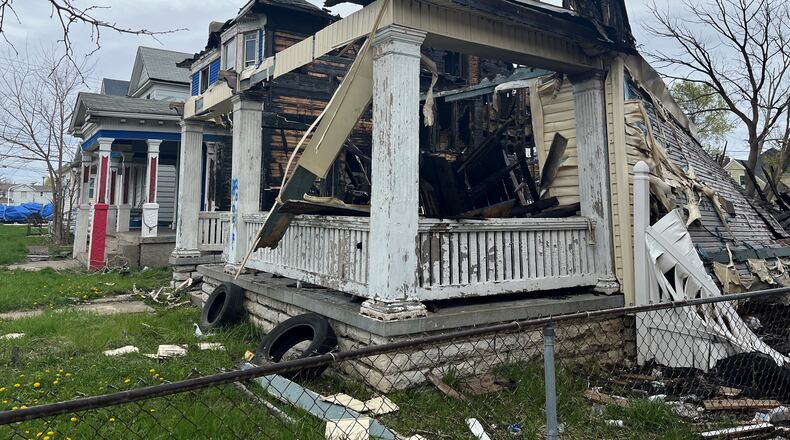Fires in vacant buildings are more likely to be intentionally set, often by firebugs who want to cause damage and vandalism, or sometimes by people who are trying to cover up a crime or commit insurance fraud, officials say.
Fire officials say community members can help prevent fires in empty buildings by reporting trespassers and notifying the city when buildings aren’t secured, like with plywood boards.
“Ensuring that vacant properties are secured properly is a priority for the city of Dayton, and citizens are encouraged to report nuisance and/or vacant property issues needing (to be) addressed,” said Dayton Fire Captain Brad French.
More than before
The Dayton Fire Department responded to 82 vacant-structure fires in 2021, or 13 more than in 2020 (a 19% increase), according to department data.
The department fought and extinguished 170 occupied-structure fires in 2021, which was 17% fewer incidents than in the prior year.
Dayton is home to thousands of vacant and abandoned structures that often attract unwanted activities like illegal dumping, drug use and prostitution, and they can become hangouts for drug users and dealers.
Dayton firefighters responding to a vacant garage fire on the 100 block of Grove Street a few months ago found mattresses and people’s belongings inside, and a neighbor told them squatters often stay there.
Trespassers sometimes start fires after using heat sources like cooking, heating or electrical equipment or by smoking or lighting candles or flames near combustible materials.
Fires in vacant residential buildings across the nation cause hundreds of millions of dollars worth of damage every year, and fires in vacant structures can spread to adjacent properties and pose significant risks to those residents and public safety forces who respond.
“Vacant structure fires are dangerous situations for firefighters across Ohio,” said Mike Taylor, the president of the Ohio Association for Professional Fire Fighters (OAPFF).
In January, a fire in a vacant home at 28 S. Findlay St. in East Dayton spread to an empty home and an occupied home next door, according to a fire incident report.
The fire in the first vacant structure was so intense that it was not safe for firefighters to enter the property, and fire crews in the other unoccupied structure were pulled out after the blaze became too involved, the report says.
Two firefighters in the occupied structure at one point fell through the floor but fortunately were not injured.
The cause of the fire was not immediately determined.
Arson common
More than half of the vacant-structure fires in Dayton last year were intentionally set, according to fire department data.
In comparison, only about 11% of occupied-building fires were determined to be the work of arsonists.
Fire investigators last year were unable to tell if blazes were accidental or arson in nearly one-third of vacant-structure fires and about one-fifth of occupied-structure fires, the data show.
Fire-damaged vacant properties hurt neighborhood aesthetics and drag down property values, frustrating neighbors. They also attract pests, illegal dumping and other things neighbors don’t want.
Some fire-ravaged properties are knocked down via emergency demolition rather quickly, if they are determined to be structurally unstable. But many burned-out eyesores remain standing for years.
Dayton plans to significantly reduce blight in its neighborhoods by putting about $15.8 million of its federal rescue funds toward property demolition.
City leaders say they expect the city will be able to knock down basically all of the vacant and deteriorating structures on its nuisance list that cannot rehabbed.
Lodia Furnas, president of the Burkhardt/Springfield neighborhood association, said some deteriorating and fire-damaged eyesores in her area have been standing a long time and she worries the city won’t get around to taking them down anytime soon.
Furnas said she wishes more people who live in her neck of the woods would call the police to report trespassers in vacant properties.
She said oftentimes residents only contact the city when they see intruders in vacant structures next to their own, or close nearby.
“Every now and then, someone will call, but unless it’s right next to them they say it’s not” my problem, she said.
Fires are more common in unsecured vacant properties than those that are secured and boarded up.
The city recently issued a request for proposals seeking companies to help secure about 1,750 vacant residential and commercial structures.
“The need for boarding is to help protect the health, safety, and welfare of citizens,” said Steven Gondol, Dayton’s deputy director of planning, neighborhoods and development. “Until a use/reuse for the property is identified, the city needs the recourse available to it to authorize boarding to prevent trespassing, theft, damage, arson, and harm to an individual and adjacent properties.”
Citizens can use the Dayton Delivers app to report issues in their neighborhoods, including vacant buildings that need to be secured, said Captain French.
French also said fire investigators rely on tips from witnesses and community members to help identify suspects in arson cases.
Earlier this year, witnesses helped police identify a person suspected of setting a trash fire on the porch of a large vacant apartment property on Riverside Drive.
The 55-year-old Dayton suspect previously was arrested and charged with arson and criminal damaging for setting a garage on fire.
About the Author





